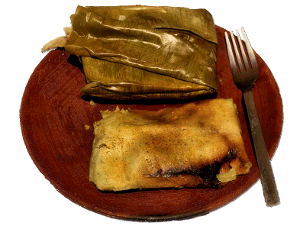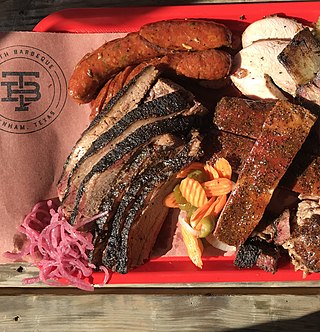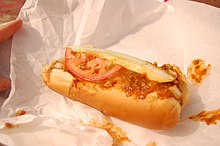
Mexican cuisine consists of the cooking cuisines and traditions of the modern country of Mexico. Its earliest roots lie in Mesoamerican cuisine. Its ingredients and methods begin with the first agricultural communities such as the Olmec and Maya who domesticated maize, created the standard process of nixtamalization, and established their foodways. Successive waves of other Mesoamerican groups brought with them their cooking methods. These included: the Teotihuacanos, Toltec, Huastec, Zapotec, Mixtec, Otomi, Purépecha, Totonac, Mazatec, Mazahua, and Nahua. With the Mexica formation of the multi-ethnic Triple Alliance, culinary foodways became infused.

Midwestern cuisine is a regional cuisine of the American Midwest. It draws its culinary roots most significantly from the cuisines of Central, Northern and Eastern Europe, and Indigenous cuisine of the Americas, and is influenced by regionally and locally grown foodstuffs and cultural diversity.

A tamale, in Spanish tamal, is a traditional Mesoamerican dish made of masa, a dough made from nixtamalized corn, which is steamed in a corn husk or banana leaves. The wrapping can either be discarded prior to eating or used as a plate. Tamales can be filled with meats, cheeses, fruits, vegetables, herbs, chilies, or any preparation according to taste, and both the filling and the cooking liquid may be seasoned.

A hot dog is a food consisting of a grilled or steamed sausage served in the slit of a partially sliced bun. The term hot dog can refer to the sausage itself. The sausage used is a wiener or a frankfurter. The names of these sausages commonly refer to their assembled dish. Hot dog preparation and condiments vary worldwide. Typical condiments include mustard, ketchup, relish, onions in tomato sauce, and cheese sauce. Other toppings include sauerkraut, diced onions, jalapeños, chili, grated cheese, coleslaw, bacon, and olives. Hot dog variants include the corn dog and pigs in a blanket. The hot dog's cultural traditions include the Nathan's Hot Dog Eating Contest and the Oscar Mayer Wienermobile.

A chili dog is a hot dog served in a bun and topped with a meat sauce, such as chili con carne. Additional toppings may include cheese, onions, and mustard. The style has multiple regional variations in the United States, many calling for specific and unique sauce ingredients, types of hot dogs, or types of buns and referred to regionally under region-specific names.

The cuisine of the Southwestern United States is food styled after the rustic cooking of the Southwestern United States. It comprises a fusion of recipes for things that might have been eaten by Spanish colonial settlers, cowboys, Native Americans, and Mexicans throughout the post-Columbian era; there is, however, a great diversity in this kind of cuisine throughout the Southwestern states.

A Chicago-style hot dog, Chicago Dog, or Chicago Red Hot is an all-beef frankfurter on a poppy seed bun, originating from the city of Chicago, Illinois. The hot dog is topped with yellow mustard, chopped white onions, bright green sweet pickle relish, a dill pickle spear, tomato slices or wedges, pickled sport peppers, and a dash of celery salt. The complete assembly of a Chicago hot dog is said to be "dragged through the garden" due to the many toppings. The method for cooking the hot dog itself varies depending on the vendor's preference. Most often they are steamed, water-simmered, or less often grilled over charcoal.

Superdawg is a drive-in hot dog stand with carhop service. It is located in the Norwood Park neighborhood of Chicago, at the intersection of Milwaukee, Devon, and Nagle Avenues. Superdawg has the distinction of being one of the few original drive-in restaurants left in the United States. Its methods have been the same since it opened in 1948. A second, similar location on Milwaukee Avenue in Wheeling, Illinois opened in 2010.

A Coney Island hot dog, Coney dog, or Coney is a hot dog in a bun topped with a savory meat sauce and sometimes other toppings. It is often offered as part of a menu of classic American "diner" dishes and often at Coney Island restaurants. It is largely a phenomenon related to immigration from Greece and the region of Macedonia to the United States in the early 20th century.

Patrick "Deep Dish" Bertoletti is an American competitive eater from Chicago.

A hot dog stand is a business that sells hot dogs, usually from an external counter. Hot dog stands can be located on a public thoroughfare, near a sports stadium, in a shopping mall, or at a fair. They are often found on the streets of major American cities. According to one report, some hot dog stands are paying up to $80,000 in rent for prime locations in Manhattan.

Different areas of the world have local variations on the hot dog, in the type of meat used, the condiments added, and its means of preparation.

The culture of Chicago, Illinois is known for the invention or significant advancement of several performing arts, including improvisational comedy, house music, industrial music, blues, hip hop, gospel, jazz, and soul.

The Polish Boy is a sausage sandwich native to Cleveland, Ohio. It consists of a link of kielbasa sausage placed in a bun, and covered with a layer of french fries, a layer of barbecue sauce and a layer of coleslaw. While the sausage is typically grilled, some establishments will quickly deep fry the sausage after grilling and prior to assembling the sandwich.

Mexican street food, called antojitos, is prepared by street vendors and at small traditional markets in Mexico. Street foods include tacos, tamales, gorditas, quesadillas, empalmes, tostadas, chalupa, elote, tlayudas, cemita, pambazo, empanada, nachos, chilaquiles, fajita and tortas, as well as fresh fruit, vegetables, beverages and soups such as menudo, pozole and pancita. Most are available in the morning and the evening, as mid-afternoon is the time for the main formal meal of the day. Mexico has one of the most extensive street food cultures in Latin America, and Forbes named Mexico City as one of the foremost cities in the world in which to eat on the street.

Texan cuisine is the food associated with the Southern U.S. state of Texas, including its native Southwestern cuisine influenced Tex-Mex foods. Texas is a large state, and its cuisine has been influenced by a wide range of cultures, including Tejano/Mexican, Native American, Creole/Cajun, African-American, German, Czech, Southern and other European American groups.

















